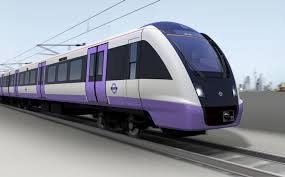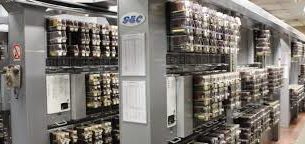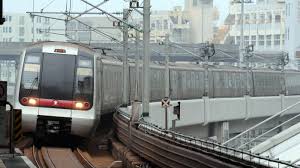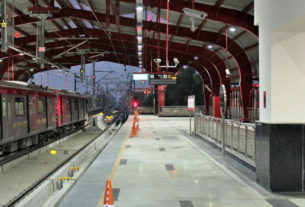Train stopped between stations Metro Rail
Train stopped between stations Metro Rail – (i) If a Train Operator cannot isolate a defect on his train and is unable to move it under its own power, he shall secure the train and request the Traffic Controller for assistance;
(ii) the Traffic Controller shall, if possible, instruct the Train Operator of the following train to drive as close to the stalled train as possible under Coded Manual mode and at the limit of authority under cab signaling;
(iii) the Traffic Controller shall then instruct the Train Operator of the assisting train to change to Restricted Manual mode, and to proceed at reduced speed and stop about ten meters short of the stalled train;
(iv) in case it is more convenient to provide assisting train from the leading end direction, the Traffic Controller shall instruct the Train Operator of the assisting train, to detrain the passengers at the station, to change the cab and proceed in the direction of the stalled train under Coded Manual mode as far as limit of authority under cab signaling and thereafter change to Restricted Manual mode and stop short of about ten meters of stalled train;
(v) the Traffic Controller shall instruct the Train Operator of defective train to secure his train, and instruct the Train Operator of the assisting train to couple to the defective train by mechanical means only and to isolate all electrical connections to the defective train;
(vi) once the trains are confirmed as coupled, the Traffic Controller shall instruct the Train Operator of the defective train to release the brakes of his train;
(vii) the Traffic Controller shall then authorise the Train Operator of the assisting train, if in front, to once again change the cab and to drive forward in Restricted Manual mode at slow speed while exchanging communication with the front cab of defective train until the assisting train has completely reached on platform of the next station;
(viii) The combined consist shall then be moved forward until the defective train has completely reached on platform and then, the passengers of the defective train shall be detrained at the station and the combined consist shall be moved to the depot;
(ix) the Train Operator of the assisting train, if in the rear, will drive the combined consist in Restricted Manual mode at a speed not exceeding ten kilometer per hour, while exchanging communication with the Train Operator of the defective train in the lead cab until thedefective train is at the platform of the next station;
(x) all passengers shall be detrained from the defective train, and the combined consist shall then be moved further until the assisting train is completely on the platform;
(xi) all passengers of assisting train shall then be detrained at the station and the combined consist worked to the depot in Restricted Manual mode ata speed not exceeding ten kilometer per hour, with leading and intermediate Train Operators exchanging communication on cab to cab telephone particularly if being assisted from rear.
(2) (i) If traction power is lost, all trains shall coast as far as the momentum of the train and the signaling system permit, after ascertaining from Traffic Controller that there is no defect in the overhead contact wire or third rail system, as the case may be. The objective is to get every train to a platform or as close to the platform as possible where passengers can be detrained if the incident is likely to be prolonged;
(ii) if the traction power has not been restored within fifteen minutes, passengers shall be detrained from all trains at stations, and the process of detraining passengers from any T rain stopped between stations shall be initiated after switching off third rail power supply, or overhead power supply in case of side evacuation, as the case may be, and the Train Operator shall also take suitable measures of securing his train;
(iii) the traffic Controller shall advise the Station Controllers of the adjoining station to which evacuation is planned, who shall in turn make suitable arrangement for assisting the evacuation process and, if applicable, in-train baggage tagging for identification of passenger baggage later;
(iv) after evacuation of passengers, the Traffic Controller shall take appropriate action of working the stranded trains to nearest station siding or depot using other suitable shunting vehicles.
(3) (i) If a train cannot be moved as a result of derailment or a mechanical failure, leading to possible infringement, the Train Operator of the stalled train shall switch on the flasher light, secure the train, and immediately inform the Traffic Controller advising him of any infringement on other track (if any) and possibility of injuries to passengers among other things, and also inform him that he is unable to move his train;
(ii) the traffic controller in consultation with the Train Operator shall decide the most appropriate method of evacuation, assistance needed and working of failed train cars taking into account proximity of stations, availability of trains and other local conditions and, advise the Train Operator the direction from which assistance is to be provided and inform the Station Controller at the station to which passengers shall be evacuated;
(iii) the following methods of evacuation, as the case may be, shall be followed, namely: ––
(a) evacuation to a train on the same track;
(b) evacuation to a train on an adjacent track (except in twin tunnel sections);
(c) evacuation to train on adjacent track (in twin tunnels);
(d) evacuation on foot to the nearest station;
(e) evacuation by climbing down the viaduct or climbing up the evacuation shaft in tunnels;
(4) Evacuation to a train on the same track:
(a) (i) Wherever considered necessary, the traffic on the adjacent track may be stopped, as prescribed under Special Instructions;
(ii) If being assisted by an assisting train from the rear, passengers shall, if possible, be first detrained from the assisting train at station and the Traffic Controller shall instruct the Train Operator to drive in Coded Manual mode until the limit of authority under cab signaling;
(iii) the Traffic Controller shall, thereafter, instruct the Train Operator to change to Restricted Manual mode and drive at not more than twenty five kilometer per hour to stop about ten meter from the stalled train;
(iv) if assistance from the rear is not possible, assistance may be provided from the front end direction, following similar procedure once the Train Operator has changed the cab for driving in the other direction as provided in the special instructions;
(b) the Train Operator of the assisting train shall report to the Operations Control Center when he has reached this location and the Traffic Controller shall then instruct him to move his train slowly and stop it ten meters short of the stalled train;
(c) the Train Operator of the assisting train shall secure his train, and open the appropriate side or end door and ramps (if any), and the Train Operator of the stalled train shall open the corresponding door on his train and the two T rain Operators shall assist passenger to shift from the stalled train to the assisting train and where applicable the assisting metro staff or the Train Operator of the stalled train shall also take appropriate measures for in-train baggage tagging for identification of passenger baggage later;
(d) when all passengers have been transferred, the doors and ramps(if any), of both the trains shall be closed and secured;
(e) the Train Operator of the stalled train shall remain with his train and the Train Operator of the assisting train shall move to the other cab and report to the Traffic Controller that all passengers have been transferred and that his train is ready to move;
(f) only after receiving the instructions from the Traffic Controller, the Train Operator of the assisting train shall select Restricted Manual mode and drive the train to the station from which he came where passengers can be detrained.
(5) Evacuation to a train on an adjacent track (except in twin tunnel sections): (a) if assistance cannot easily be given by a train on the same track, a train on the adjacent track may be used;
(b) on receipt of a request for assistance, the Traffic Controller shall inform the Station Controllers at the station on the either side of the location of the incident;
(c) the Passengers may be detrained from the assisting train at a station;
(d) the Traffic Controller shall instruct the Train Operator of the assisting train to select Coded Manual mode and proceed towards the stalled train as near as permissible and then, select Restricted Manual mode in consultation with the Traffic Controller and drive his train to a point, near the stalled train;
(e) the Train Operator of the assisting train shall secure his train and open the appropriate door of his train and report completion to the Traffic Controller.
(f) the Traffic Controller shall then instruct the Train Operator of the stalled train to open appropriate door and ramp (if any) of his train;
(g) the two T rain Operators shall then supervise the transfer of passengers via the ramps or step ladders and the track from the stalled train to the assisting train taking particular care to inform passengers of the dangers of tripping on rails and other equipment, and where applicable, the assisting metro staff or the Train Operator of the stalled train shall also take appropriate measures for in-train baggage tagging for identification of passenger baggage later;
h) once all passengers have been transferred, the doors and ramps (if any), shall be secured and completion reported to the Traffic Controller by the Train Operator of the assisting train;
(i) the Train Operator of the stalled train shall remain with his train;
(j) the Traffic Controller shall then authorise the Train Operator of the assisting train to proceed to the next station in the normal direction of traffic, where normal service may be resumed.
(6) Evacuation to train on an adjacent track (in twin tunnels):
(a) In twin tunnel sections, if assistance cannot easily be given by a train on the same track, a train on the adjacent track may be used;
(b) on receipt of request for assistance, the Traffic Controller shall inform the Station Controllers at the station on the either side of the location of the incident;
(c) Passengers may be detrained from the assisting train at a station;
(d) The Traffic Controller shall instruct the Train Operator of the assisting train to select Coded Manual mode and proceed toward the direction of stalled train as near as permissible to an appropriate Cross Passage as advised by Traffic Controller and then change to Restricted manual mode in consultation with Traffic Controller to drive his train to a point, near a Cross Passage as advised by the Traffic Controller;
(e) The Train Operator of the assisting train shall secure his train and open the appropriate door and ramp (if any), of his train and report completion to the traffic controller;
(f) the Traffic Controller shall then instruct the Train Operator of the stalled train to open its appropriate door and ramp (if any), as applicable, which is nearest to this Cross Passage;
(g) the two Train Operators shall then supervise the transfer of passengers via the Cross Passage and the track from the stalled train to the assisting train taking particular care to inform passengers of the dangers of tripping on rails and other equipment, and the hazards of walking through the Cross Passage, and the two Train Operators shall ensure that all passengers have been safely transferred and accounted for. Where applicable, the assisting metro staff or the Train Operator shall also take appropriate measures for in-train baggage tagging for identification of passenger baggage later.
(h) once all passengers have been transferred, the appropriate doors and ramps (if any), of assisting train shall be closed, secured and completion reported to the Traffic Controller by the Train Operator of the assisting train;
(i) the Train Operator of the stalled train shall close the doors and ramps (if any), and return to his train cab;
(j) the Traffic Controller shall then authorise the assisting train to select appropriate mode and proceed to the next station where normal service may be resumed.
(7) Evacuation on foot to the nearest station: (a) In case of evacuation on foot, the Traffic Controller shall decide as to which station passengers are to be evacuated which shall normally be the nearest station subject to other factors, such as the location of the rains, ventilation consideration in tunnel sections and any damage to track, train or structures which may make it desirable to use an alternative station;
(b) the Traffic Controller shall inform the Station Controller at the station designated to receive the passengers and the Station Controller shall clear the platform concerned of waiting passengers and, if necessary, stop incoming passengers, and if a tunnel section is involved, he shall ensure that the tunnel lighting is switched on, open all emergency doors, manual secondary doors and platform screen doors, where provided, and he shall position himself and his security staff on the platform to receive the arriving passengers;
(c) the Station Controller shall prepare to render assistance or first aid to any passenger who may have had difficulty or met an accident during the evacuation;
(d) on open sections and in double track tunnels, the Traffic Controller may arrange for traffic to be suspended on the adjacent track for the duration of the evacuation, and in case of Third Rail Traction system instruct the Traction Power Controller to switch off the Third Rail power supply;
(e) the Traffic Controller shall verify with the Train Operator that the train has been secured and then instruct him to deploy the appropriate door and ramp
(if any) of the train, nearest to the designated station;
(f) passengers shall be informed of the procedures to be followed and given explicit warning on tripping hazards, where to walk, or hazards of walking on the raised walkway, not to raise any object above head level, and what to expect at the station;
(g) wherever applicable, the Train Operator or assisting metro staff shall take appropriate measures for in-train baggage tagging for identification of passenger baggage later;
(h) passengers shall be detrained on the track, or on the raised walkway, as applicable, , by the Train Operator and directed to the station and the Train Operator shall count passengers as they leave the train;
(i) the Station Controller shall count the passengers as they arrive at the platform;
(j) the Train Operator shall ensure that the last passenger has left the stalled train and also check that all passengers have left the track or raised walkway,as the case may be;
(k) the Train Operator and Station Controller shall check their respective count of passengers’ numbers and satisfy themselves that all passengers have reached the platform and thereafter the Train Operator shall return to his train and secure the end door and ramp (if any) or the side doors, as the case may be;
(l) the Station Controller shall record in the station log the details of the incident, in particular, the number of passengers detrained, and then report the statistics to the Traffic Controller.
(8) Evacuation on foot by climbing down on via-duct or climbing up the evacuation shaft in tunnels:
(a) If the train is near a suitable location designated for evacuation of passengers by climbing down the via-duct or climbing up the evacuation shaft in tunnels, the Train Operator of stalled train shall consult the Traffic Controller and on instructions from Traffic Controller, secure his train;
(b) the Traffic Controller shall intimate the Station Controllers of adjoining stations for assisting in the evacuation, who shall depute competent metro staff and security personnel at the safe evacuation point to assist the evacuation;
(c) the assisting metro staff shall prepare to render assistance or first aid to any passenger who may have had difficulty or accident during the evacuation;
(d) the Traffic Controller may arrange for traffic to be suspended on the adjacent track for the duration of the evacuation;
(e) on the advice of the Traffic Controller, the Train Operator of stalled train shall open the appropriate door or ramp (if any) of the stalled train;
(f) passengers shall be informed of the procedures to be followed and given explicit warning on tripping hazards, where to walk and not to raise any object above head level, and what to expect at the evacuation point;
(g) the assisting metro staff or the Train Operator shall take appropriate measures, where applicable, for in-train baggage tagging for identification of passenger baggage later;
(h) passengers shall be detrained on the track by the Train Operator and directed to the evacuation staircase or rescue vehicle and the Train Operator shall count passengers as they leave the stalled train;
(i) the passengers shall again be counted as they arrive at the safe location after evacuation by the assisting metro staff at the safe evacuation point;
(j) the Train Operator shall ensure that all passengers have left the stalled train and check that all passengers have left the track; (k) the T rain Operator and the assisting metro staff at the safe evacuation point or vehicle shall check their respective count of passengers’ numbers and satisfy themselves that all passengers have reached the safe evacuation point or vehicle and report the same to Traffic Controller. The Train Operator shall, thereafter, return to his train, secure the end door, and seek further instructions from Traffic Controller;
(l) the evacuated passengers shall be brought to nearest station; (m) the concerned Station Controller shall record in the station log the details of the incident, and, in particular, the number and other details of passengers detrained, and transfer of their luggage and repeat the complete incidence details to the Traffic Controller.
(9) If a train can not be moved as a result of failure of Traction system the Train Operator shall consult the Traffic Controller who in turn shall consult the Traction Power Controller, and after ensuring that it is not possible to restore Traction power, shall arrange to cut off Traction power in the affected section and take any further measures for safety of passengers and then action, in accordance with sub-rules (5) to (8), wherever applicable, shall be taken to evacuate the passengers from the stalled train.
(10) Notwithstanding, anything contained in sub-rules (1) to (9), in the case of Third Rail Traction system, the Third Rail power supply shall be ‘switched off’ in all cases of evacuation in which passengers are required to come on the raised walkway or the track.



